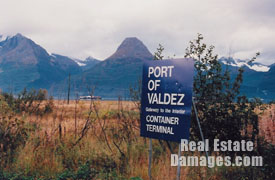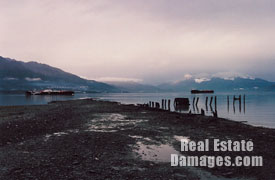Research
Exxon Valdez
Bligh Reef
Prince William Sound, Alaska
Class VIII - Environmental Condition, Oil Spill
![]()
 |
Port of Valdez, Alaska |
The Exxon Valdez spill was not a particularly large spill, not even ranking as one of the world's Top 10, however, it is probably the best known. At 12:04 am, on March 24, 1989, an oil tanker loaded with 1,264,155 barrels of North Slope crude oil ran aground on Bligh Reef in the northeastern portion of Prince William Sound, Alaska. Approximately one-fifth of the cargo, 11.2 million gallons, spilled into the ocean. Containment efforts were started, however, after three days of calm seas, strong northeasterly winds arose and dispersed the oil beyond any hope of containment. Some oil formed a floating sheen, while the rest mixed with seawater, creating a thick emulsion known as mousse, which does not burn and is difficult to clean up. The sheen and mouse spread over a 470-mile trajectory from Prince William Sound to the Alaska Peninsula. 790 miles of Prince William Sound coastline were oiled, of which 200 miles were heavily oiled. In the Kenai Peninsula-Kodiak region, more than 2,400 miles of coastline were oiled. The damage to wild life was high; 100,000-300,000 birds and 2,650 sea otters were killed, and fishing was severely impacted.
 |
Old Valdez Town Site |
While the tanker loaded its cargo at the end of the Alaska Pipeline in Valdez, no oil ever hit the town of Valdez itself. It was mostly limited to remote wilderness areas. Unlike many environmental disasters, the spill did not impact subterranean soils or the groundwater. Therefore, property remediation efforts were limited to the coastline surfaces, which were easily accessed and the verification of complete cleanup was much more assured. Additionally, because the contamination involved crude oil on the surface, rather then refined petroleum with chemical additives in the soils, bio-remediation (natural disintegration) and evaporation assisted greatly in restoring the coastline surfaces. As nearly all the impacted coastline was wilderness, the real estate damages related to the temporary disruptions of logging, recreational uses, fishing, subsistence lifestyles (living off the land) and mining. The impact on property values was computed on a case-by-case basis; they were based on the level of oil on the coast and the disruption, if any, to their use of the land. The large amounts of money spent in the clean-up efforts actually created a stronger demand for some real estate, as many people came from out-of-state to live and work by the many new remediation-related jobs created by the spill.
<<Return to Research Page
